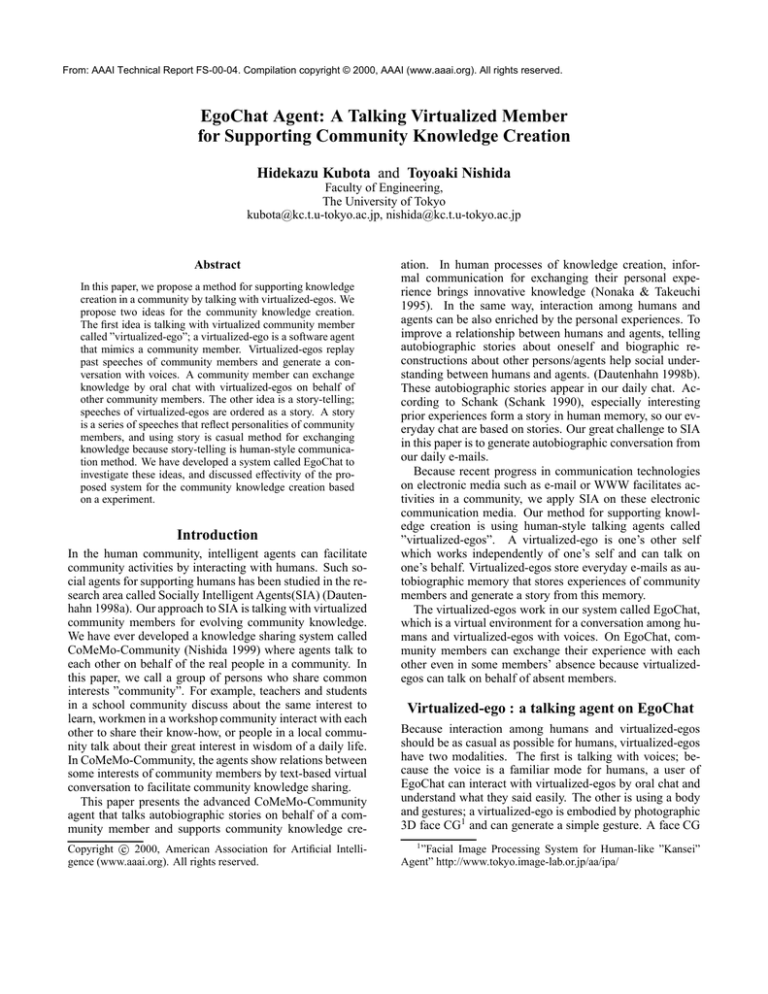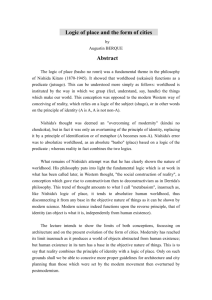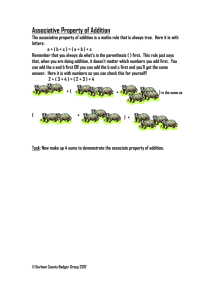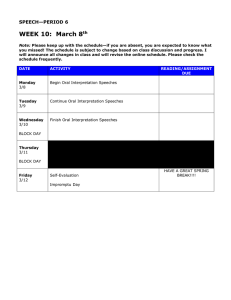
From: AAAI Technical Report FS-00-04. Compilation copyright © 2000, AAAI (www.aaai.org). All rights reserved.
EgoChat Agent: A Talking Virtualized Member
for Supporting Community Knowledge Creation
Hidekazu Kubota and Toyoaki Nishida
Faculty of Engineering,
The University of Tokyo
kubota@kc.t.u-tokyo.ac.jp, nishida@kc.t.u-tokyo.ac.jp
Abstract
In this paper, we propose a method for supporting knowledge
creation in a community by talking with virtualized-egos. We
propose two ideas for the community knowledge creation.
The first idea is talking with virtualized community member
called ”virtualized-ego”; a virtualized-ego is a software agent
that mimics a community member. Virtualized-egos replay
past speeches of community members and generate a conversation with voices. A community member can exchange
knowledge by oral chat with virtualized-egos on behalf of
other community members. The other idea is a story-telling;
speeches of virtualized-egos are ordered as a story. A story
is a series of speeches that reflect personalities of community
members, and using story is casual method for exchanging
knowledge because story-telling is human-style communication method. We have developed a system called EgoChat to
investigate these ideas, and discussed effectivity of the proposed system for the community knowledge creation based
on a experiment.
Introduction
In the human community, intelligent agents can facilitate
community activities by interacting with humans. Such social agents for supporting humans has been studied in the research area called Socially Intelligent Agents(SIA) (Dautenhahn 1998a). Our approach to SIA is talking with virtualized
community members for evolving community knowledge.
We have ever developed a knowledge sharing system called
CoMeMo-Community (Nishida 1999) where agents talk to
each other on behalf of the real people in a community. In
this paper, we call a group of persons who share common
interests ”community”. For example, teachers and students
in a school community discuss about the same interest to
learn, workmen in a workshop community interact with each
other to share their know-how, or people in a local community talk about their great interest in wisdom of a daily life.
In CoMeMo-Community, the agents show relations between
some interests of community members by text-based virtual
conversation to facilitate community knowledge sharing.
This paper presents the advanced CoMeMo-Community
agent that talks autobiographic stories on behalf of a community member and supports community knowledge creCopyright c 2000, American Association for Artificial Intelligence (www.aaai.org). All rights reserved.
ation. In human processes of knowledge creation, informal communication for exchanging their personal experience brings innovative knowledge (Nonaka & Takeuchi
1995). In the same way, interaction among humans and
agents can be also enriched by the personal experiences. To
improve a relationship between humans and agents, telling
autobiographic stories about oneself and biographic reconstructions about other persons/agents help social understanding between humans and agents. (Dautenhahn 1998b).
These autobiographic stories appear in our daily chat. According to Schank (Schank 1990), especially interesting
prior experiences form a story in human memory, so our everyday chat are based on stories. Our great challenge to SIA
in this paper is to generate autobiographic conversation from
our daily e-mails.
Because recent progress in communication technologies
on electronic media such as e-mail or WWW facilitates activities in a community, we apply SIA on these electronic
communication media. Our method for supporting knowledge creation is using human-style talking agents called
”virtualized-egos”. A virtualized-ego is one’s other self
which works independently of one’s self and can talk on
one’s behalf. Virtualized-egos store everyday e-mails as autobiographic memory that stores experiences of community
members and generate a story from this memory.
The virtualized-egos work in our system called EgoChat,
which is a virtual environment for a conversation among humans and virtualized-egos with voices. On EgoChat, community members can exchange their experience with each
other even in some members’ absence because virtualizedegos can talk on behalf of absent members.
Virtualized-ego : a talking agent on EgoChat
Because interaction among humans and virtualized-egos
should be as casual as possible for humans, virtualized-egos
have two modalities. The first is talking with voices; because the voice is a familiar mode for humans, a user of
EgoChat can interact with virtualized-egos by oral chat and
understand what they said easily. The other is using a body
and gestures; a virtualized-ego is embodied by photographic
3D face CG1 and can generate a simple gesture. A face CG
1
”Facial Image Processing System for Human-like ”Kansei”
Agent” http://www.tokyo.image-lab.or.jp/aa/ipa/
"!$##%&' ( )*#,+-#/.+-0213435
I?2-
?m$"N~mQ
°±$²2³I²°´"´
µ-¶´"²
· ¸¹º"· »· ¸I¼m½4» ·|¾2¿w¾
z|{~}FeFF
687:9;<
48 I¡N¢*£8¤ 2"¤
Figure 1: Screen shot of EgoChat system
ÀÂÁ~ÃÄ$ÅQÆÇNÄ"ÈYÇNÄ$ÉÊQË_ÅNÌÌÉÍ~ÅQÌ
äåæmçwèAåéê|êwë ì$íïî?çÂæð$é
ää
Û$ÜÝIÞßàAáâ8ÞÂÝã$á
ÛÛ
clears who is the original person of the virtualized-ego and
its gesture shows a degree of interest in a topic in a conversation.
Figure 1 shows a screen shot of EgoChat. A user is talking
with three virtualized-egos, each of which has the face CG
of another community member.
Moreover, the virtualized-ego emphasizes her/his believability by not telling a robotic message but talking about personal stories of a real community member.
Story in human relationships
When virtualized-egos tell a story, they generate it from their
personal memories that consist of past speeches of community members. Text-based messages of a community member exchanged on electronic media such as mailing-lists,
electronic bulletin boards, and so on, are summarized and
uttered, and then stored in memory of her/his virtualizedego. Oral messages are also recorded in the memory of
virtualized-ego when a member tell her/his thoughts to
virtualized-egos on EgoChat.
Speeches of virtualized-egos are ordered as a story. In this
research, we define a story as a series of speeches that represent personalities of community members. When we observe conversations in a mailing-list, we find that a speaker
of the mailing-list inclined to talk with a special member
who had the same interests as the speaker had. We therefore assumed that members in a general community have
this kind of inclination about conversation, and that the inclination represents personalities of community members. On
EgoChat, each of virtualized-egos selects a message from
her/his personal memories and tell it to each other orderly.
Topical messages follow the theme, and the order of messages is characterized by the above-mentioned inclination in
order that virtualized-egos may reflect social relationships in
a community.
¥2¦m§~¨e©ª4ªA¦«¨¬Q­8®4¯
ÎÂÏÐ-ÏÑQÒÓÒaÔÕ:Ö
ÑNÕØ×Ù8ÔÔÏIÚ~Ô×
=?>A@B4B4C
gh
ijjkmlIn opqrqsrtuwv4v4vx4y
DFEGIH-JLKNM4E4OQPR?S-PT:U:VWYXZ
[A\8]_^]a`^bcedddf
Figure 2: Overview of EgoChat system
Overview of EgoChat
The EgoChat system consists of three storytelling processes
and two storage processes (2). In the storytelling processes, community members can share their knowledge by
creating a knowledge stream with their virtualized-egos.
When a user would like to gain community knowledge, s/he
inputs her/his interest into EgoChat by using voice messages(storytelling process(a)). Voice messages of the user
are recognized by a commercial speech recognition system, then virtualized-ego(VE)s start talking about related
topic(storytelling process(b)). Virtualized-egos will continue talking with each other if the user doesn’t interrupt
the conversation to comment on speeches of virtualized-egos
or change a present topic to another topic(storytelling process(c)).
While talking with virtualized-egos, personal memory of
a community member is enriched in the storage processes.
Before using EgoChat system, the personal memories are
stored in virtualized-egos by using automated summarizing
technology or summarizing humanly from past speeches exchanged on electronic media such as mailing-lists(storage
process(1)). These personal memories are described by
structured lists in HTML, and this enables people to edit
and browse their personal memories by using ordinary editors and browsers. Besides text-based speeches, virtualizedegos store newly commented oral messages of a user on
EgoChat(storage process(2)), thus virtualized-egos tell community knowledge in past speeches of community members
and users add new ideas into their virtualized-egos in a loop
of community knowledge creation.
(a) a set of topics
that virtualized-ego "A" has
travel
Japan
brandy
sake
beer
France
Kyoto City
(b) some speeches about the topic "brandy"
(b1)
I used to drink V.S.O.P
sights
Eiffel Tower
(a) Free reminding
(b2)
(b3)
.
.
.
I’m fond of diluted brandy
... ...
.
.
.
(the day)
(whom I met)
Sunday, Oct 17
Toyoaki Nishida
play tennis
(what happened)
wondered
(result)
(b) Story-flow
Figure 3: Example of a topics-and-summaries set
Figure 4: Example of associative representations
Storytelling by virtualized-egos
Virtualized-egos generate messages in turn, and these messages are ordered as a story by following processes.
I) (Beginning of a turn)
II) Each virtualized-ego selects a message associated with
a topic from the personal memory.
III) Only a virtualized-ego whose message is presented in a
most orderly and most reasonable way in a context speaks
the message.
IV) The turn ends, and the next turn begins.
By repeating the process of generating and selecting messages stated above, virtualized-egos can tell a story.
In following three section, we propose two sets of representations of the personal memory that characterize a
personality of a virtualized-ego as an agent of a community member; and lay out how to decide an appropriate
virtualized-ego in process III).
Topics-and-summaries representation
Each virtualized-ego has a set of topics. Past speeches of
a community member related to each topic are filed away
into personal memory of a virtualized-ego. For example,
when a virtualized-ego in a community of liquor fans has
topics such as ”brandy”, ”beer” and ”sake”(Fig. 3(a)), some
speeches about ”brandy” such as ”I used to drink V.S.O.P.” ”
I’m fond of diluted brandy.”(Fig. 3(b)) are stored in a memory of the virtualized-ego and speeches about other topics
are stored in the same way.
Flow-of-topics representation
Virtualized-egos change topics at some intervals by referring to an associative representation set (Hirata, Maeda, &
Nishida 1998) of a flow of topics.
The associative representation proposed on the work of
CoMeMo-Community consists of many-to-many hyperlinks
that associate one or more key unit with one or more value
unit. The semantics of the associative representation is not
defined strictly. Instead, we leave the interpretation of the semantics to human association based on our tacit background
knowledge. As a result, the associative representation permits raw information materials to be accumulated with minimal overhead. In return, interpretation of such information heavily relies on tacit community knowledge (Maeda
& Nishida 1998). An example of associative representations
is illustrated in Figure4.
(a) Free reminding: Figure 4(a) denotes that from given
concepts of “travel” as a key, one reminds of “Japan”
and “France” as values, and from concepts of “sights” and
“Japan” as keys, one reminds of “Kyoto City”as a value.
Ten persons have ten different free reminding, and such
free reminding is suitable for representing tacit knowledge in narrative mode (Bruner 1986).
(b) Story-flow: The associative representation is also able
to show story-flow, as shown in Figure 4(b) that denotes
an example of diary using the associative representation.
A coherence of a story relies on human association since
keys and values in the associative representation are connected by an association of whom generated the associative representation, and there is little lack of the coherence
in a community (Hirata, Maeda, & Nishida 1998). For example, in Figure 4(b) a community member who belongs
to the same community as an author of the diary can understand why the author wondered.
In the case of virtualized-ego(a)(Fig.5), ’liquor’ is a key
virtualized-ego(a)
liquor
brandy
beer
virtualized-ego(b)
liquor
sake
wine
Figure 5: Example of a flow-of-topics set
Figure 6: Screen shot of the experimental EgoChat system
unit and ’brandy’ and ’beer’ are value units. This associative
representation of virtualized-ego(a) shows a flow of topics
from liquor to brandy or beer, and other associative representation such as virtualized-ego(b) has shows other flow of
topics.
Associative representations that shows associations of a
community member are stored with “topics and summaries”
in a memory of a virtualized-ego. One mediator selected
by a user among virtualized-egos selects the next topic that
is associated with the current topic, for instance, the message for changing topics is as follows; “I associate liquor
with brandy. Next, let’s talk about brandy.” We suppose that association-based flows of topics make storytelling
of virtualized-egos human-like and helps users to believe
virtualized-egos as community members’ other selves which
work independently.
Storytelling by ordered messages
In a turn, though all the virtualized-egos select messages associated with a topic at the same time, only one virtualizedego is selected to speak at a time by comparing priorities of
selected messages. Each virtualized-ego generates a priority
when it selects a message, and a criteria to decide priorities
of virtualized-egos is as follows;
Story structure: a frequency of exchange between
virtualized-egos follows that between community members in order that a stream of messages may reflect
social relationships between community members. The
frequency of exchange between a community member
and the another member on mailing-lists and between
a user and a virtualized-ego on EgoChat is recorded
in each virtualized-ego. For example, when community member(a) inclined to talk with member(b) more
than community member(c) and the virtualized-ego
of member(b) has talked in the previous turn, not the
virtualized-ego of member(c) but that of member(a) is
prior in the present turn.
Coherence: a virtualized-ego that selects the following
message after a message mentioned just before is prior in
order to exchange messages coherently. The summaries in
a personal memory are labeled with key words that represent contents of the summaries in a word. A message
is regarded as the one that follows the previous message
when its keyword matches the previous one.
Fairness: a virtualized-ego that speaks little is prior to that
speaks a lot, in order to exchange messages fairly.
Experiment
We have made a basic experiment on usability of the
EgoChat system to investigate effects of a voice interaction
between humans and agents. The experimental system is implemented by using Java and Java3D API on MS-Windows
OS. The voices of virtualized-egos are not generated by textto-speech software but recorded human voices. A body of a
virtualized-ego consists of a sphere head and a cone body,
and the sphere head was shaken up and down while talking.
Figure 6 shows a screen shot of the experimental EgoChat
system. The virtualized-egos have no face and the difference between them is only their voices and names. While
upper-left virtualized-ego named “Miyoko” is talking, centered characters shows the key word “sprite”(a brand of
juice) of the message that she says. Upper-right virtualizedego named “Kouji” and lower-left virtualized-ego named
“Tetuya” have mentioned about the key word “dislike” in
the past.
Method
We created four virtualized-egos and generated their personal memories from a humanly summarized log of a mailing list about liquor where participants exchanged ideas
about how to sell brandy. Each virtualized-ego represents
a participant of the mailing list. The subjects were three
postgraduate students in our laboratory who have ordinary
knowledge about liquor and they are not participants of the
mailing list. Each subject is shown the conversation of
virtualized-egos about brandy during three minutes and can
comment on a speech of a virtualized-ego when s/he feels
an interest
in the speech.
ñ
Following example is a conversation between virtualizedegos A,B,C and D and a subject 2 .
1: A ”Let’s begin talking about brandy.”
2: B ”We have more prejudice against brandy than other
liquor.”
3: A ”I often chat over drinking.”
4: C ”A public bar doesn’t deal in brandy because brandy
is too expensive.”
5: B ”Yes, certainly.”
6: A ”Sure.”
7: Subject ”Convenience stores don’t deal in brandy too.”
8: C ”Shouchu 3 is more low-priced than brandy.”
...
In the conversation, Line 4 follows Line 3 mainly because
of a criteria for storytelling about coherence. Both messages have been humanly labeled with the same key word
”shouchu” in advance since these two messages originally
appeared in the context of advantages of shouchu. And short
responses such as ”Yes, certainly.” and ”Sure.” are randomly
inserted other than messages from the personal memories to
make the conversation rhythmic.
After the conversation, the subjects answered following
question: ”By which method do you think easier to comment on speeches of other persons between text-based mailing lists and the EgoChat system?”
Results and Discussion
Two subjects answered that the EgoChat system is easier
and more casual method to comment on messages of other
members than mailing list because a chat-style conversation with voices facilitates their interaction with virtualizedegos. This result suggests that using storytelling agents
with voices may facilitate interaction between humans and
agents. On our previous system, CoMeMo-Community,
we evaluate how much people shared their knowledge by
virtual exchanging of the messages with text-based words
and images. The result is satisfactory (Hirata & Nishida
1999)(Nishida 1999), hence, we expect that the EgoChat,
using more human-like modalities such as voices and gestures, brings community members more knowledge than
CoMeMo-Community.
The last one subject answered that interacting with
virtualized-egos is too unnatural to communicate smoothly
because virtualized-egos can’t answer to his question. Truly,
a storytelling method on EgoChat is not enough to tell concise responses to users, on the other hand, EgoChat can easily store and process a great number of messages because a
representation of personal memories and methods of ordering messages are very simple. We are planning to apply the
EgoChat to large community over a network practically and
evaluate what amount of knowledge is created in the community, in this case, EgoChat has the merit of dealing large
data.
2
the conversation was originally in Japanese.
3
Japanese distilled Liquor made from wheat or rice.
We foresee a lot of potential application areas, including
application to campus communities that consist of professors and students, an integral part of knowledge management in a company (i.e., horizontal communities orthogonal
to the job hierarchy), local commercial communities (i.e.,
shops and consumers), communities of volunteers, and so
on. Currently, we apply the EgoChat system to a public
opinion channel(POC)(Nishida et al. 1999) which is a novel
communication medium for sharing and exchanging opinions in a community. POC is a kind of broadcasting system
for a community that collects messages from members and
feeds edited stories back to them. The EgoChat plays mainly
a broadcasting part in POC.
Related Work
Technologies of conversational agents that support our
thinking process are discussed in some works. SAGE
(Umaschi 1996) agent helps to generate autobiography of
a user to enable the user to explore her/his inner world. Rea
(Cassell et al. 1999) and Imp Character 4 work with humanlike interaction to explain commercial information to the
customers. Each agent in these studies works alone and talks
from one point of view, in contrast, EgoChat works with
many agents and the agents talk from various view points of
the community members. Therefore, the user can gain many
views about a topic on EgoChat.
CommunityPlace 5 , InterSpace 6 , and BodyChat (Vilhjlmsson 1997) are graphical chat system that allow users
to communicate synchronously via their avatars. EgoChat is
a new asynchronous communication channel for a community that has a casual and conversational flavor. The virtual
chat which the EgoChat system provides is applicable to a
community formed over an asynchronous media, i.e., mailing lists or electronic bulletin boards.
Conclusion
In this paper, we proposed a new method for supporting
community knowledge creation. We focused on a believable design of agents that help social activities of humans
and have introduced two ideas of our method based on storytelling. We have developed a system called EgoChat which
supports knowledge creation in a community by humanstyle conversation with voices between humans and virtualized community members called virtualized-egos. We discussed usability of EgoChat based on a experiment. As a
future work, we are planning to apply the EgoChat to large
community over a network practically and evaluate the usefulness of the system.
References
Bruner, J. 1986. Actual Minds, Possible Worlds. Harvard
University Press,Cambridge, MA and London.
4
Extempo, http://www.extempo.com/
SONY VirtualSocietyProject, http://vs.sony.co.jp/
6
NTT Human Interface Laboratories, http://www.hil.ntt. co.jp/
5
Cassell, J.; Vilhjlmsson, H.; Chang, K.; Bickmore, T.;
Campbell,
L.; and Yan, H. 1999. Requirements for an arò
chitecture for embodied conversational characters. In Computer Animation and Simulation ’99 (Eurographics Series).
Dautenhahn, K. 1998a. The art of designing socially intelligent agents - science, fiction, and the human in the loop.
Special Issue ”Socially Intelligent Agents”, Applied Artificial Intelligence Journal 12(7-8):573 – 617.
Dautenhahn, K. 1998b. Story-telling in virtual environments. In Working Notes Intelligent Virtual Environments,
Workshop at the 13th biennial European Conference on Artificial Intelligence (ECAI-98).
Hirata, T., and Nishida, T. 1999. Supporting community
knowledge evolution by talking-alter-egos metaphor. In
The 1999 IEEE Systems, Man, and Cybernetics Conference
(SMC’99).
Hirata, T.; Maeda, H.; and Nishida, T. 1998. Facilitating community awareness with associative representation. In Proceedings Second International Conference on Knowledge-Based Intelligent Electronic Systems
(KES’98), 411 – 416.
Maeda, H., and Nishida, T. 1998. Generating and understanding weak information structures by humans. In Artificial Intelligence and Soft Computing(ASC’98), 74–78.
Nishida, T.; Fujihara, N.; Azechi, S.; Sumi, K.; and Yano,
H. 1999. Public opinion channel for communities in the
information age. New Generation Computing 14(4):417–
427.
Nishida, T. 1999. Facilitating community knowledge evolution by talking vitrualized egos. In Bullinger, H.-J., and
Ziegler, J., eds., Human-Computer Interaction VOLUME
2. Lawrence Erlbaum Associates, Pub. 437–441.
Nonaka, I., and Takeuchi, H. 1995. The KnowledgeCreating Company: How Japanese Companies Create the
Dynamics of Innovation. Oxford University Press.
Schank, R. C. 1990. Tell Me a Story: A New Look at Real
and Artificial Memory. NewYork: Scribner.
Umaschi, M. 1996. Sage storytellers: Learning about identity, language and technology. In Proceedings of ICLS ’96,
AACE, 526 – 531.
Vilhjlmsson, H. H. 1997. Autonomous communicative
behaviors in avatars. Master’s thesis, Master’s Thesis of
Massachusetts Institute of Technology.



